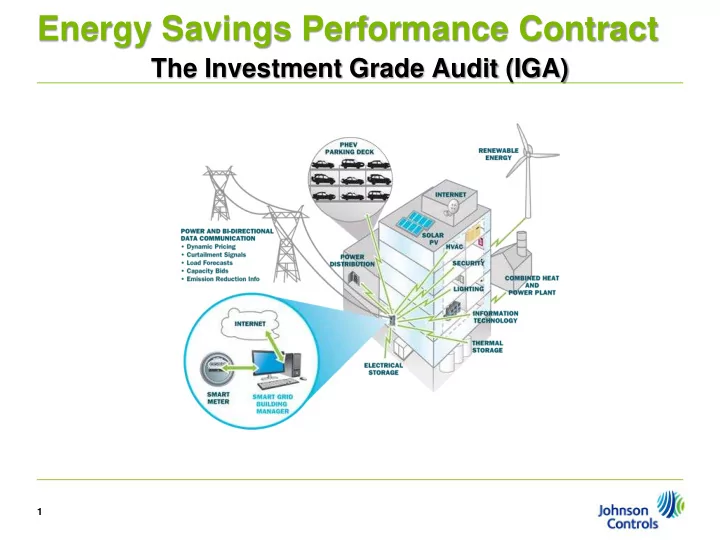

Energy Savings Performance Contract The Investment Grade Audit (IGA) 1
Agenda What is an Investment Grade Audit (IGA) The Purpose of the IGA IGA Role in the ESPC Process Key IGA Components Systems Evaluated in the IGA Data Needed for IGA IGA Deliverables ECM Examples Costs of an IGA Discussion / Questions 2
What is an Investment Grade Audit (IGA)? A process that entails a very thorough, calculated and detailed analysis to identify cost-effective energy conservation measures (ECMs). IGA scope of work is based on preliminary utility assessment and customer requirements. IGA can be targeted to focus on specific systems of interest. Can include aspects of both Level 2 & Level 3 Audits as defined by the American Society of Heating, Refrigerating, and Air Conditioning Engineers (ASHRAE) as shown on following slide. 3
4
What is the Purpose of the IGA? To provide all information that may become part of the final Energy Savings Performance Contract Significant details to understand the project scope and benefits Technical and Financial to be able to track the savings throughout the life of the project or term of the contract 5
IGA Role in the ESPC Process Process varies based upon Method of Procurement Issue RFQ/RFP Realize Savings *Select ESCO(s) ESCO Implements ECMs Negotiate Investment Grade Execute ESP Contract Audit (IGA) Contract (if applicable) Issue IGA Contract (if applicable) Negotiate ESP Contract ESCO(s) performs IGA Final Selection of ESCO 6
Key IGA Components A detailed account of energy and water use by facility Energy benchmarking (comparison of usage to similar facilities within similar geography) Breakdown of energy use in the building Rate analysis Review of existing conditions Development of potential Energy Conservation Measures (ECMs) Identification of Operation and Maintenance Improvement strategies that could produce savings Cost / savings analysis of each identified ECM 7
Key IGA Components Project proposal of bundled measures (Scope of Work) Measurement & Verification (M&V) Plan Ongoing Operations and Maintenance Requirements Implementation Plan Commissioning Plan Financial Plan (Includes Fixed Price, Savings and Finance Options) Other Potential IGA Components Whole Building Modeling Sub-metering Detailed Energy Modeling Life Cycle Cost Analysis 8
Potential Energy Conservation Measures Lighting Heating, Ventilating and Air Conditioning (HVAC) Equipment Building Envelope Steam Systems Chilled Water Domestic Hot Water Other Water Using Systems Building Controls Energy Generation and Distribution Waste Management Systems Technology Systems (phone, internet, computers, etc.) 9 9
Data needed for the IGA 24 months of Utility Bills Occupancy Schedules Required Occupancy Comfort Conditions (if established) Temperatures / Humidity desired during occupied times Any required air changes Temperatures / Humidity for unoccupied times Accurate description of existing building conditions and current operations Building Inventory with square footage Asbestos Reports Hazardous Materials 10
Site Visits Discuss facility operation Comfort problems and space requirements Recent facility improvements Conduct equipment survey Measure all important parameters, collect data, install data loggers Identify approach to hazardous materials (if any) Commissioning documents Computerize maintenance system records 11 11
IGA Deliverables Facilities description and status Future plans for building use Existing needs assessment from maintenance and occupants Baseline of energy consumption Review and approve Consider what-ifs Analysis of each proposed energy conservation measure (ECM) Review cost and savings estimates Ensure the measurement and verification plan is viable for each measure 12 12
IGA Deliverables Firm Fixed Price for Scope of Work Savings Estimates and Guarantee Financing Model (including interest rate, finance term, annual service payment, agreed upon escalation factor) Commissioning Plan Construction / Implementation Plan Measurement and Verification Plan 13 13
Investment Grade Audit Cost? Cost can vary based on targeted Scope of Work and Complexity of Building Systems Under an ESPC, cost of the IGA must be covered by the savings/benefit No cost to the client if stated objectives are not achieved by the ESCO If stated objectives are achieved, but client does not move forward with contract, Client pays ESCO established amount stated in IGA Contract / PDA (if applicable). IGA typically costs $0.10 – $0.15 per audited square foot 14
U.S. Department of Energy Typical Costs for Energy Assessments Level 1 ─ $0.03/ft2 - $0.10/ft2 Level 2 ─ $0.11/ft2 - $0.25/ft2 Level 3 ─ $0.26/ft2 - $0.70/ft2 These are audit costs that we have seen for state and federal government audits, but building complexity, size of facility, and distance auditor has to travel all affect final costs. Information from: http://www1.eere.energy.gov/wip/solutioncenter/pdfs/theenergyauditprocessandstateapplications.pdf 15
Discussion / Questions State Procurement Process ESCO’s are required to invest capital up front to perform an investment grade audit RFP Response may have 2 or 4 ESCOs may get short-listed Investment of $100,000 or more each RFP response Pros / Cons This limits competition and eliminates smaller firms This increases the cost to all potential projects (unsuccessful ESCOs sunk IGA costs) State stipend to purchase IGA’s from unsuccessful bidders typically under the actual value Possible Solutions Consider other States Procurement Processes for ESPCs Limit IGA Investment to (1) Successful ESCO vs. Short-List Limit Short-List to Maximum of (2) ESCOs Other? 16
Thank you! 17
Recommend
More recommend